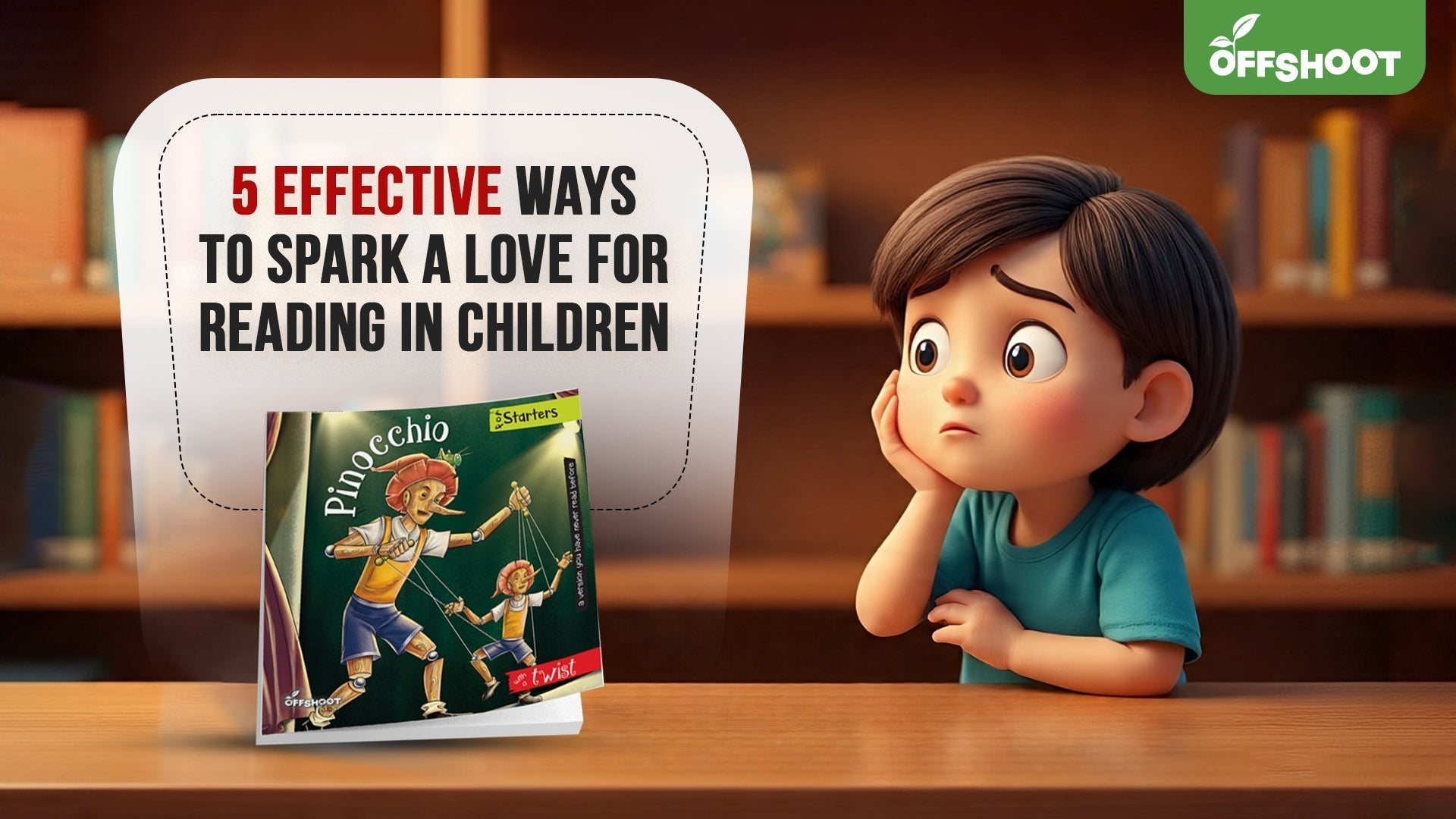
5 Effective Ways to Spark a Love for Reading in Children
| Offshoot Books
In today's fast-paced, screen-saturated world, getting kids excited about reading can feel like a challenge. But instilling a love for books, especially English story books, isn’t just about building vocabulary—it’s about opening doors to imagination, empathy, and lifelong learning. Whether you’re raising a toddler or a tween, there are simple, proven ways to make story books a natural and joyful part of your child’s life. Here are five effective strategies to help your child fall in love with reading—outside the classroom.
1. Create a Reading-Friendly Home Environment
If books are buried at the bottom of a toy box, guess what? Your child probably won’t reach for them. But if they’re part of your home’s everyday setup—visible, inviting, and accessible—reading starts to feel like a natural pastime.
Make Story Books Easily Accessible
Place story books in English where your child can reach them: on low shelves, baskets by the bed, even in the car. Rotate them regularly to keep things fresh. Include a mix of English story books—fairy tales, adventures, comics, and picture books. The more variety, the more likely they’ll find something they love.
Set Up a Cozy Reading Corner
Designate a quiet, comfy spot just for reading. Add a beanbag, a few cushions, soft lighting, and shelves stocked with story books to read. Make this their safe little world, where they can curl up with a good book and let their imagination run wild. When reading feels like a retreat, it becomes a habit they’ll look forward to every day.
2. Let Them Choose Their Own English Story Books
Kids are more excited to read when they feel in control of what they’re reading. Think of it like picking out clothes—they’re more likely to wear what they choose themselves, right? The same logic applies to story book English selections.
Empowering Choice Encourages Reading
Take your child to a bookstore or library and let them browse. Don’t worry if they go for silly books, graphic novels, or even comic strips. If they’re flipping pages, they’re reading—and that’s a win.
Use Libraries and Bookshops as Discovery Zones
Make visits to libraries and bookstores a regular family outing. Let your child explore and discover new authors, characters, and genres. Librarians are often great at recommending age-appropriate English story books based on your child's interests. Pro tip: sign them up for a library card—kids love having their own!
3. Make Reading a Shared Family Activity
Reading doesn’t have to be a solo gig. In fact, it shouldn’t be—at least not in the beginning. Kids fall in love with books when reading becomes a shared experience full of laughter, questions, and cozy moments.
Read Aloud with Enthusiasm and Expression
Storytime isn’t just about the words—it’s about the performance. Use different voices, act out the scenes, make funny faces. It’s not just reading; it’s theater. Even older kids enjoy being read to when it’s done with energy and heart.
Encourage Story Discussions and Emotional Connections
After reading a story, ask open-ended questions: “What would you have done in that situation?” or “Why do you think the dragon was lonely?” These conversations help children relate to characters and absorb lessons organically. Books become more than just stories—they become life teachers.
4. Integrate Story Books into Daily Routines
Habits stick when they’re part of the rhythm of everyday life. So instead of treating reading like homework, weave it into your family's daily flow.
Replace Screen Time with Book Time
It’s tempting to hand over a tablet or phone to keep your child busy. But what if a story book in English became the go-to distraction? Keep books in the car, at the dining table (for solo reading time), and even in the bathroom. Turn idle moments into reading opportunities.
Use Bedtime Stories as a Daily Ritual
One of the easiest—and most effective—ways to build a reading habit is to end each day with a story. No matter how busy life gets, 10–15 minutes of bedtime reading not only soothes kids but also strengthens your bond. Bonus: children associate reading with comfort and safety.
5. Celebrate Progress and Make Reading Fun
Kids thrive on positive reinforcement. Acknowledge their efforts, celebrate milestones, and turn reading into a game—not a task.
Create Reading Challenges and Milestone Rewards
Try a sticker chart for every book completed. Or start a “reading passport” that gets stamped with each finished story book. Set fun goals like, “Read five books this month and earn a movie night.” It adds a sense of purpose and accomplishment.
Use Games, Activities, and DIY Story Books to Reinforce the Habit
Turn stories into activities: act them out, draw the characters, or rewrite the ending. Even better—create a DIY story book English project where your child writes and illustrates their own tale. When they become the storyteller, their engagement goes through the roof.
Conclusion – Building Lifelong Readers Starts at Home
Raising a child who loves reading isn’t about strict schedules or elite-level books—it’s about creating joyful, relaxed, and meaningful interactions with story books. When you provide the right environment, give them the freedom to choose, and read with them—not to them—you’re building a foundation that lasts a lifetime.
So stock your shelves with English story books, make space for reading in your daily routine, and above all, have fun with it. Books aren’t just tools for learning—they’re companions, adventures, and passports to whole new worlds. And once your child discovers that magic, there's no going back.

Leave a comment
Your email address will not be published.